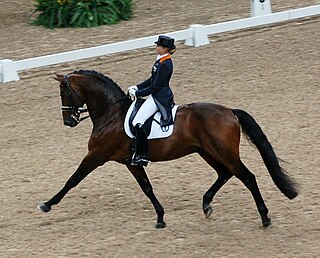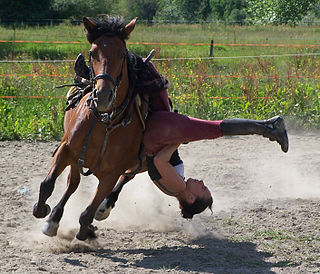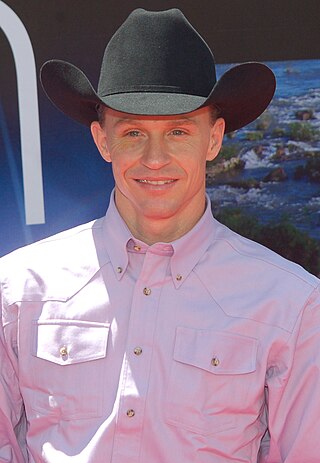
Dressage is a form of horse riding performed in exhibition and competition, as well as an art sometimes pursued solely for the sake of mastery. As an equestrian sport defined by the International Equestrian Federation, dressage is described as "the highest expression of horse training" where "horse and rider are expected to perform from memory a series of predetermined movements".

Equestrianism, commonly known as horse riding or horseback riding, includes the disciplines of riding, driving, and vaulting. This broad description includes the use of horses for practical working purposes, transportation, recreational activities, artistic or cultural exercises, and competitive sport.

Rodeo is a competitive equestrian sport that arose out of the working practices of cattle herding in Spain and Mexico, expanding throughout the Americas and to other nations. It was originally based on the skills required of the working vaqueros and later, cowboys, in what today is the western United States, western Canada, and northern Mexico. Today, it is a sporting event that involves horses and other livestock, designed to test the skill and speed of the cowboys and cowgirls. American-style professional rodeos generally comprise the following events: tie-down roping, team roping, steer wrestling, saddle bronc riding, bareback bronc riding, bull riding, breakaway roping, and barrel racing. The events are divided into two basic categories: the timed events and rough stock events. Depending on sanctioning organization and region, other events such as goat tying and pole bending may also be a part of some rodeos. The "world's first public cowboy contest" was held on July 4, 1883, in Pecos, Texas, between cattle driver Trav Windham and roper Morg Livingston.

Bull riding is a rodeo sport that involves a rider getting on a bucking bull and attempting to stay mounted while the animal tries to buck off the rider.

A jockey is someone who rides horses in horse racing or steeplechase racing, primarily as a profession. The word also applies to camel riders in camel racing. The word "jockey" originated from England and was used to describe the individual who rode horses in racing. They must be light, typically around a weight of 100–120 lb. (45–55 kg), and physically fit. They are typically self-employed, and are paid a small fee from the horse trainer, whose colors they wear while competing in a race. They also receive a percentage of the horse's winnings. The job has a very high risk of debilitating or life-threatening injuries, not only from racing accidents but also, because of strict weight restrictions, from eating disorders.

A riding boot is a boot made to be used for horse riding. The classic boot comes high enough up the leg to prevent the leathers of the saddle from pinching the leg of the rider, has a sturdy toe to protect the rider's foot when on the ground and has a distinct heel to prevent the foot from sliding through the stirrup. The sole is smooth or lightly textured to avoid being caught on the tread of the stirrup in the event of a fall.

Equitation is the art or practice of horse riding or horsemanship.

Sidesaddle riding is a form of equestrianism that uses a type of saddle which allows riders, generally female, to sit aside rather than astride an equine. Sitting aside dates back to antiquity and developed in European countries in the Middle Ages as a way for women in skirts to ride a horse in a modest fashion while also wearing fine clothing. It has retained a specialty niche even in the modern world.

A buttero or cavalcante is a mounted herder, usually of horses, of cattle, or of buffaloes, in Italy, predominantly in the Maremma region of Tuscany and northern Lazio, or in the Pontine Marshes to the south.

The Spanish Riding School is an Austrian institution based in Vienna, dedicated to the preservation of classical dressage and the training of Lipizzaner horses, whose performances in the Hofburg are also a tourist attraction. The leading horses and riders of the school also periodically tour and perform worldwide. It is one of the "Big Four", the most prestigious classical riding academies in the world, alongside the Cadre Noir, the Portuguese School of Equestrian Art, and the Royal Andalusian School.

Endurance riding is an equestrian sport based on controlled long-distance races. It is one of the international competitions recognized by the FEI. There are endurance rides worldwide. Endurance rides can be any distance, though they are rarely over 160 km for a one-day competition.

Trick riding refers to the act of performing stunts while horseback riding, such as the rider standing upright on the back of a galloping horse, using a specially designed saddle with a reinforced steel horn, and specialized kossak loops for hands and feet. The horse is likewise galloping free. Trick riding is not to be confused with equestrian vaulting, which is an internationally recognized competitive sport governed by the Federation Equestre Internationale (FEI).
The National Finals Rodeo (NFR) is the premier championship rodeo of the Professional Rodeo Cowboys Association (PRCA). It showcases the talents of the PRCA's top 15 money winners in the season for each event.

Ty Monroe Murray, is an American former professional rodeo cowboy. He competed in the three "roughstock" events; bareback bronc riding, saddle bronc riding, and bull riding. He won nine world championships in the Professional Rodeo Cowboys Association (PRCA); seven in all-around and two in bull riding. He was also one of the co-founders and a board adviser of the Professional Bull Riders (PBR). From 2005 to 2020, he was also a regular color commentator for several televised PBR events.

A saddle is a supportive structure for a rider of an animal, fastened to an animal's back by a girth. The most common type is equestrian. However, specialized saddles have been created for oxen, camels and other animals. It is not known precisely when riders first began to use some sort of padding or protection, but a blanket attached by some form of surcingle or girth was probably the first "saddle", followed later by more elaborate padded designs. The solid saddle tree was a later invention, and though early stirrup designs predated the invention of the solid tree, the paired stirrup, which attached to the tree, was the last element of the saddle to reach the basic form that is still used today. Today, modern saddles come in a wide variety of styles, each designed for a specific equestrianism discipline, and require careful fit to both the rider and the horse. Proper saddle care can extend the useful life of a saddle, often for decades. The saddle was a crucial step in the increased use of domesticated animals, during the Classical Era.

Gymkhana is an equestrian event consisting of speed pattern racing and timed games for riders on horses. These events often emphasize children's participation and may be organized by a recognized Pony Club or a 4-H club. Very small rodeo-like events with little or no prize money, designed for beginners or riders at a local level, are sometimes called playdays. In parts of the western United States, this type of competition is usually called an O-Mok-See. "Gymkhana" is the word used in most of the rest of the English-speaking world, including the United Kingdom and both the East Coast and the West Coast of the United States.

Davy Russell is an Irish retired National Hunt jockey. He was Irish jump racing Champion Jockey three times, and won the Grand National (twice), the Cheltenham Gold Cup and the Grand Steeple-Chase de Paris.
Horseback riding simulators are intended to allow people to gain the benefits of therapeutic horseback riding or to gain skill and conditioning for equestrian activity while diminishing the issues of surrounding cost, availability, and individual comfort level around horses. Horseback therapy has been used by many types of therapists to advance their physical, mental, emotional, and social skills.

Catherine Durand-Henriquet is a French equestrian. She was twice selected for the Equestrian at the Summer Olympics. She brought the first Iberian horse to International and Olympic levels and was also the first rider in the Versailles tradition to ever ride in the Olympic Games. She was national dressage champion multiple times. Together with her husband, famous equestrian and dressage master Michel Henriquet, she wrote a number of major dressage and horse training books and released a young horse training DVD series showing how the Henriquets take young horses from their first time under the saddle to the Grand Prix. Catherine Henriquet still actively shows Hanoverian horses and Lusitano horses at Grand Prix level and has trained dozens of horses to the Grand Prix. She currently rides two horses on the Big Tour: 18.7 hands Hanoverian gelding Lexus Gold and 15.7 hands Lusitano gelding Diabeau du Coussoul. Henriquet is also a retired dermatologist and always maintained professional practice while showing internationally. Having a full time profession aside from riding sometimes got in the way of being able to attend international shows and selections.
Virgil F13 is a rodeo bucking horse. He is specialized mainly in bareback bronc riding, but is sometimes used in saddle bronc riding. Although born in North Dakota, United States, he has lived most of his life in Alberta, Canada. Virgil is a three-time Canadian Professional Rodeo Association (CPRA) Bareback Horse of the Year, as well as a two-time Professional Rodeo Cowboys Association (PRCA) Bareback Horse of the Year. He was also awarded the Bareback Horse of the Canadian Finals Rodeo (CFR) five times from 2015 to 2018 and 2024, as well as the Bareback Horse of the National Finals Rodeo (NFR) in 2017 and Co-Bareback Horse of the NFR in 2023. He is also the horse that was ridden for the highest-scored bareback ride in PRCA history, which occurred in 2022.

















